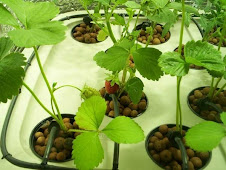pH Testing invokes this image of a mad horticulturalist muttering an arcane ritual over a set of vials when nothing could be further from the truth. pH testing is simple and easy to understand.
First off – what is pH? It stands for the rather cumbersome potentiometric hydrogen ion concentration. Simply put, it is a measure of the acidity or alkalinity of a solution. The pH scale is from 0-14 and pure water has a neutral pH of 7. Anything that would be considered acidic is rated lower than 7 and anything considered alkaline is rated higher than 7. Pretty simple.
How does this affect my hydroponic system and why test for pH? Well, different plants require different pH to get optimal growth. Testing your growing solution allows you to correct any imbalances in allowing you to grow bigger and better plants. It is one of the simplest and least technical ways to increase your produce yields and plant size. Think of it as part of providing the best home for the roots of your plants – allowing them to feed at the best rate possible. Always add the nutrients to the water before checking and adjusting the pH of your solution. Should your pH level go too high or too low the nutrients in your system will settle out – leading to deficiency and death.
The simplest and least expensive way to test water pH is paper test strips. The strips, which have a pH sensitive dye on them, change colour when dipped into your nutrient solution. You compare the colour on the strip to a colour chart to determine the Ph level. Nothing complicated about that. The only down side is that the strips can be hard to read because the colour differences can be subtle.
The most popular method to check pH is liquid test kits. The liquid test kits work by adding a few drops of pH sensitive dye to a small amount of the nutrient solution your hydroponic system uses and comparing the colour with a colour chart. These kits are a bit more expensive than the paper strip tests but are much easier to read and are extremely accurate and reliable.
For the technologically gifted, the most high-tech way to check pH is to use the digital meters. They come in a huge array of sizes and prices. The digital pen style meter is the most popular. Just simply dip the electrode into the nutrient solution for a few moments and the pH value is displayed on an LCD screen. They are very handy and easy to use. Digital meters usually need to be calibrated frequently, as the meters can drift and you must check the calibration often to insure accuracy. Most pens also require the tips to be stored in a buffer or electrode storage solution and have a reputation of breaking down without warning.
The major requirement of pH testing asks you to be able to compare colours – making the pH of nutrient solution component of your hydroponic system easy for you to understand and maintain. No mad horticulturalist and certainly no arcane rituals needed.



